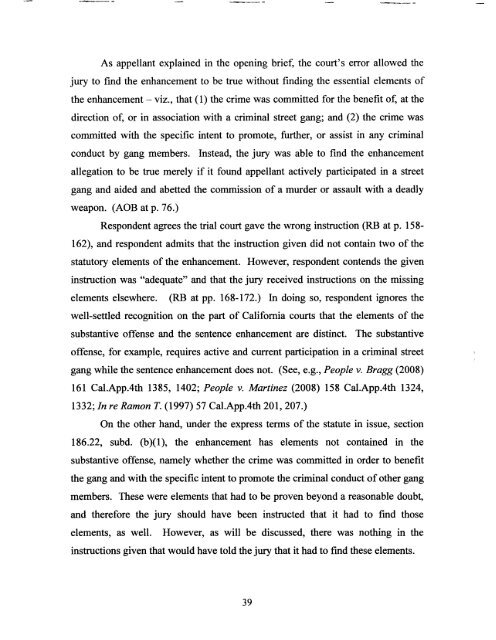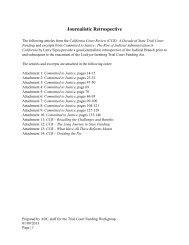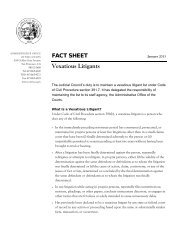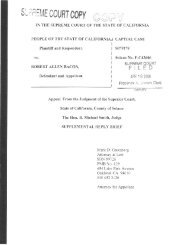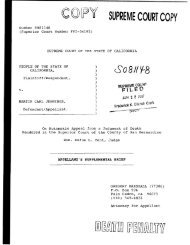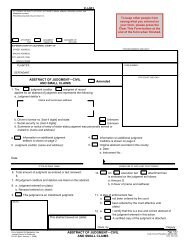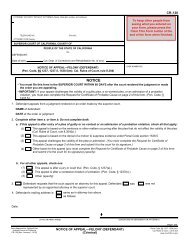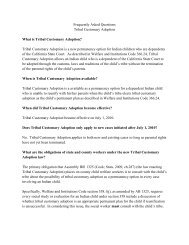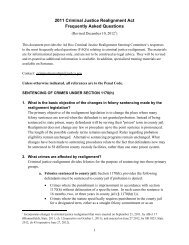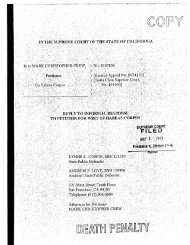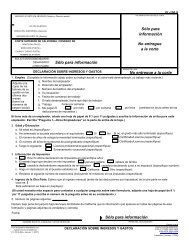Appellant, William Satele, Reply Brief - California Courts - State of ...
Appellant, William Satele, Reply Brief - California Courts - State of ...
Appellant, William Satele, Reply Brief - California Courts - State of ...
You also want an ePaper? Increase the reach of your titles
YUMPU automatically turns print PDFs into web optimized ePapers that Google loves.
As appellant explained in the opening brief, the court's error allowed the<br />
jury to find the enhancement to be true without finding the essential elements <strong>of</strong><br />
the enhancement - viz., that (1) the crime was committed for the benefit <strong>of</strong>, at the<br />
direction <strong>of</strong>, or in association with a criminal street gang; and (2) the crime was<br />
committed with the specific intent to promote, further, or assist in any criminal<br />
conduct by gang members. Instead, the jury was able to find the enhancement<br />
allegation to be true merely if it found appellant actively participated in a street<br />
gang and aided and abetted the commission <strong>of</strong> a murder or assault with a deadly<br />
weapon. (AOB at p. 76.)<br />
Respondent agrees the trial court gave the wrong instruction (RB at p. 158<br />
162), and respondent admits that the instruction given did not contain two <strong>of</strong> the<br />
statutory elements <strong>of</strong> the enhancement. However, respondent contends the given<br />
instruction was "adequate" and that the jury received instructions on the missing<br />
elements elsewhere. (RB at pp. 168-172.) In doing so, respondent ignores the<br />
well-settled recognition on the part <strong>of</strong> <strong>California</strong> courts that the elements <strong>of</strong> the<br />
substantive <strong>of</strong>fense and the sentence enhancement are distinct. The substantive<br />
<strong>of</strong>fense, for example, requires active and current participation in a criminal street<br />
gang while the sentence enhancement does not. (See, e.g., People v. Bragg (2008)<br />
161 Cal.App.4th 1385, 1402; People v. Martinez (2008) 158 Cal.App.4th 1324,<br />
1332; In re Ramon T. (1997) 57 Cal.App.4th 201,207.)<br />
On the other hand, under the express terms <strong>of</strong> the statute in issue, section<br />
186.22, subd. (b)(1), the enhancement has elements not contained in the<br />
substantive <strong>of</strong>fense, namely whether the crime was committed in order to benefit<br />
the gang and with the specific intent to promote the criminal conduct <strong>of</strong>other gang<br />
members. These were elements that had to be proven beyond a reasonable doubt,<br />
and therefore the jury should have been instructed that it had to find those<br />
elements, as well. However, as will be discussed, there was nothing in the<br />
instructions given that would have told the jury that it had to find these elements.<br />
39


